By A.N.Pandey
Director, Spiritual Awareness Program (SAP), Hyderabad, India
www.yogicconcepts.in
Every religion in the world believes in these two terms namely Soul (Atman or Rooh) and Ego (Ahamkara or I). The principle and process of their relation, journey and functional aspects are not clear while adopting the spiritual path in the form of Yoga and Meditation. An attempt has been made to unveil Origin of soul & ego and their form of existence. In addition, the topic deals with the questions like Why Soul are weak in human being? How soul is made free from nature (Prakriti) and mind? And whether soul and ego are the same?
1. Origin of soul and ego
Indian mythology provides sufficient proof for origin of soul and ego. God or Parmatma has projected two specific entity which is known as Shiva (space in science) and Shakti (energy in science). They (Shiva and Shakti) are responsible for creation of the universe. While creation the presence of God or Parmatma remains as nuclei. This means that the God or Parmatma also known as the Absolute or Truth is termed as God beyond creation; whereas Shiva (space) and Shakti (energy) along with nuclei are known as God in creation. The nuclei also termed as Bindu in Yoga Chudamani Upanishad and also in Amrit Bindu Upanishad. The same has the characteristics of Parmatma or God and termed as soul or Atma.
Shiva (space) has emerged first which in turn responsible for creation of all matters in a space (from sun and moon to the mineral kingdom). Prana (Shakti) is responsible for bringing shiva from the higher entity (from the nature’s zone) or from Prakriti. This shows the dimension of nature or Prakriti is as large as the dimension of Parmatma or God. This is also clear God is beyond the nature; but the nuclei (atman) are within the nature.
The inner instrument (Antahkarna) is the first element emerges for creation which consists of i) Mana (mind) ii) Buddhi (intellect) iii) Ego (ahamkara) and iv) Chitta (mind stuff). Hence ego is the powerful entity of Antahkarna which plays a role of providing the approval for all material function. In scientific term, inner instrument is responsible for networking in the universe where ego (ahamkara) is the controlling authority. As God or Parmatma is the controller of creation; likewise, ego is the controller of material creation. Ego is compared with soul (atma) which is the nuclei of every material. Because of similarity, ego is also compared with soul when the same (ego) is purified or dissolved. In other words, we can say that ego (impure soul) and pure soul are the two facets of a coin.
1.1 Swami Vivekananda views on Soul and Param Soul (Parmatma)
It is difficult to view the dimensional aspects of Param soul (Parmatma) and Soul (Atma). This is because; soul doesn’t have length, width, height, depth, matter etc. Then how to grasp the identity of the soul or param soul? Swami Vivekananda has given a beautiful definition of the param soul and also for the soul. He defines that soul is a circle having no circumference or infinite circumference with a center; whereas, Parmatma or God is a circle having no circumference or infinite circumference with infinite centers. Very clear definition of Swami Vivekananda about Soul and God has been capsulated in brief by the images.
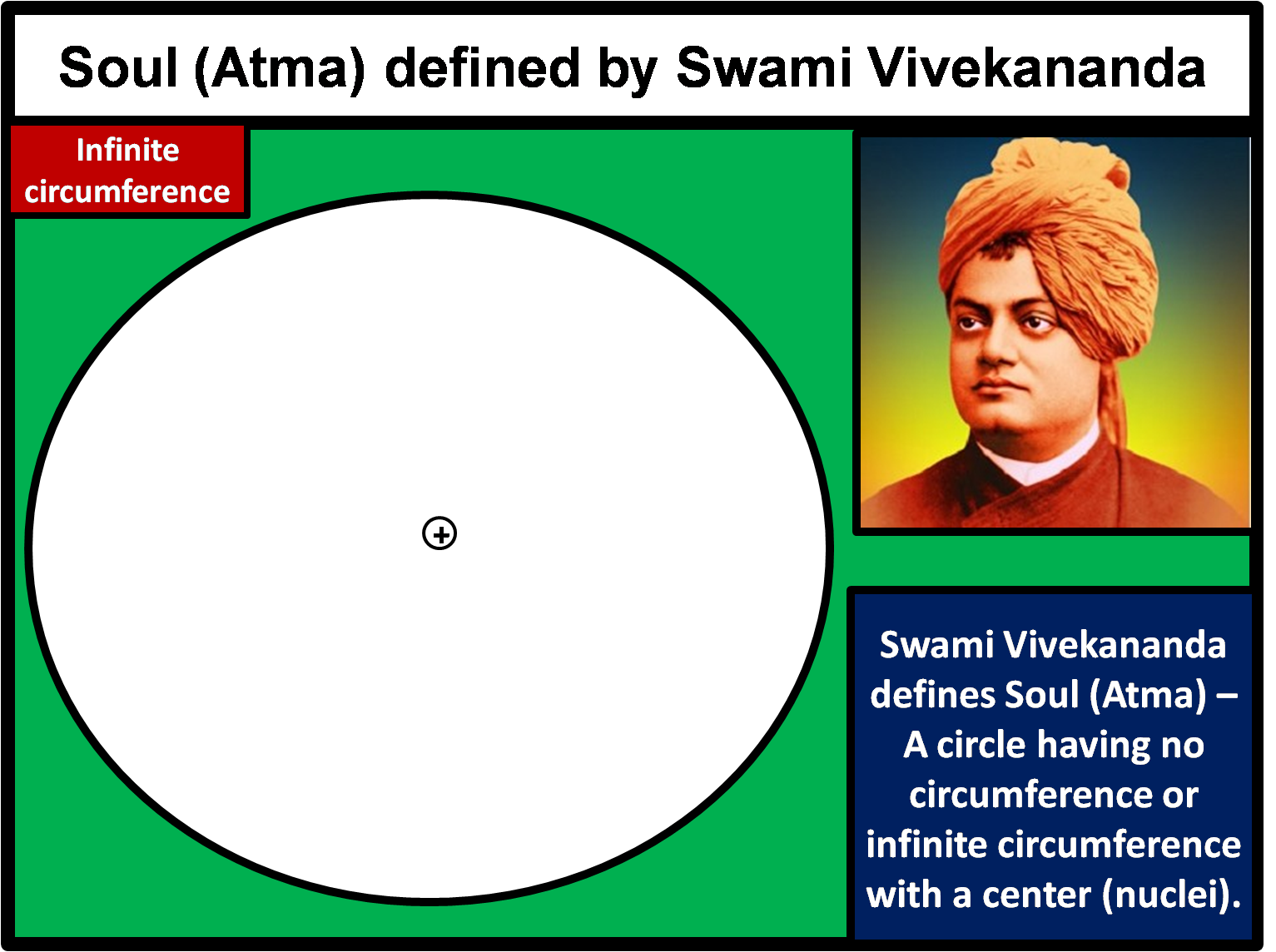
By his definition, it is very clear that the characteristics of soul and god are the same even with respect to their dimensions as both are infinite. Only difference between soul and god is one (soul) is having a center indicating individual soul as nuclei at the time of emergence of existence (or being) and the god consists of infinite centers or nucleus or souls of the universe.
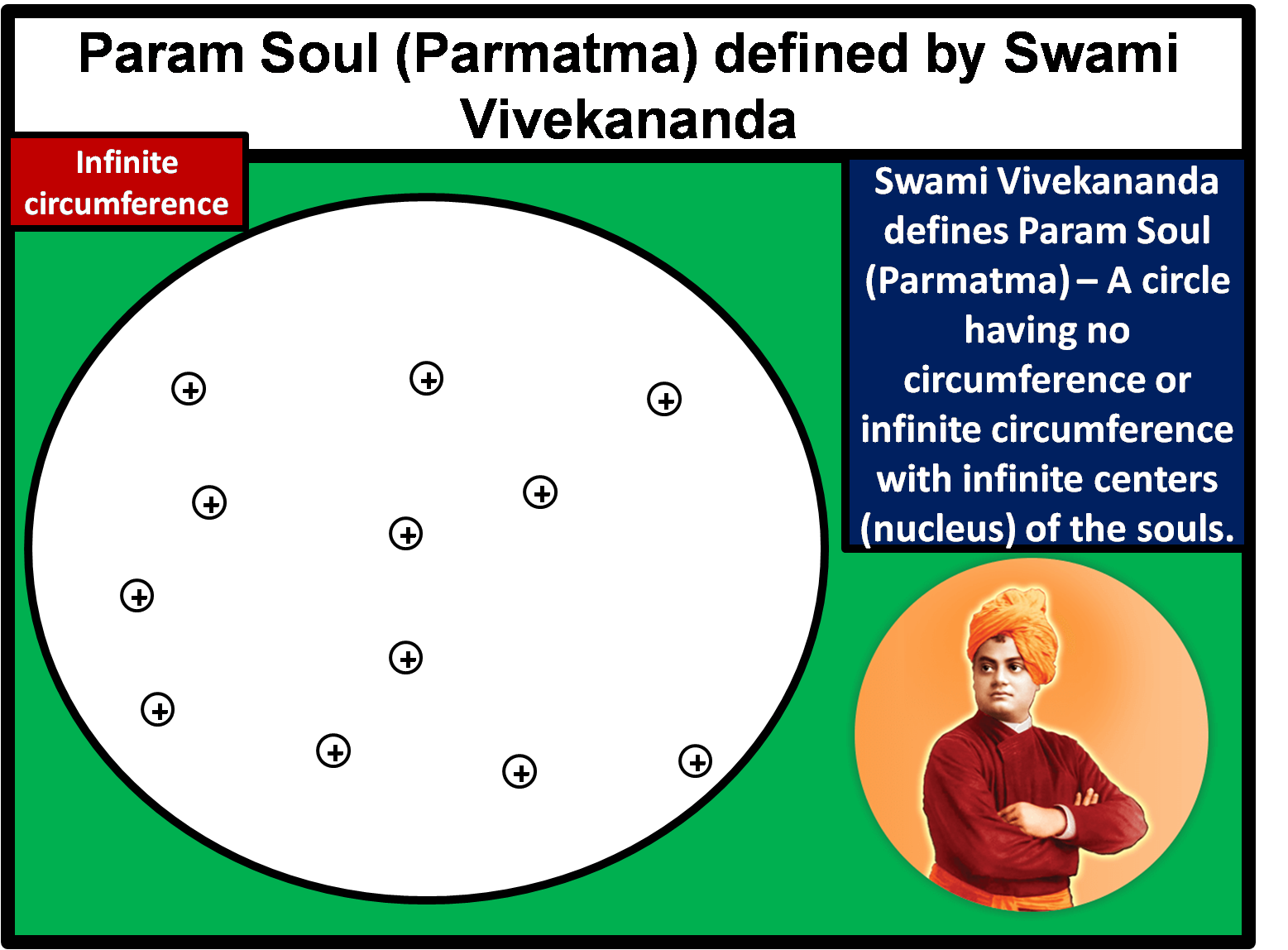
The definition given by swami Vivekananda clarifies that soul doesn’t come or enter in the human body as the same is universally pervading or existing. This also provides clarity for the questions like how and when the soul is entering in the human body. This also clarifies that how the soul is going out of human body at the time of death.
1.2 Why Soul is weak in human being?
Upanishad says that human body consists of five veils like food sheath (Annamaya Kosha), energy sheath (Pranamaya Kosha), mental sheath (Manomaya Kosha), intellect sheath (Vigyanmaya Kosha) and bliss sheath (Anandmaya Kosha). Among all, Annamaya Kosha is the prime hindrance of human evolution. This sheath is the main attraction for getting dragged to have the body consciousness. Other sheaths are also responsible to provide the veils around the soul (atman).
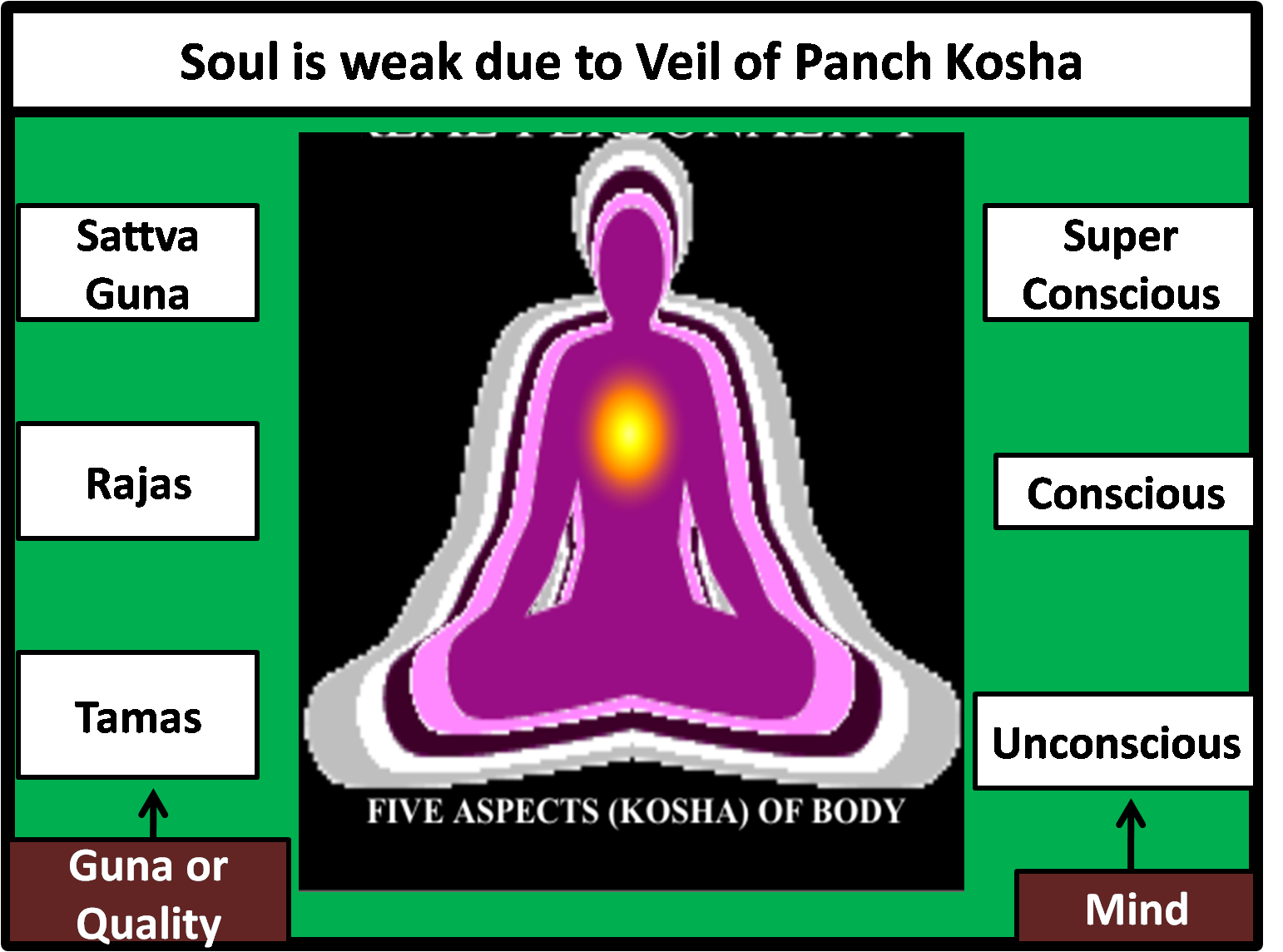
In addition, three gunas namely Tamo, Rajo and Sato guna along with three states of mind like unconscious, conscious and super conscious mind are also responsible for reflecting the human soul as weak. Yoga provides the ways to unveil the sheath as well as to uplift the mind in the realm of super consciousness. When we are at super conscious state of mind along with Sato guna, we are likely to be either in Vigyanmaya Kosha or Anandmaya Kosha.
2. Concept of Parmatma and Soul in Upanishad
Yoga Chudamani Upanishad and Tattva Suddhi scripture provides the clarity of God (Parmatma) and Soul (Atma) in nutshell. The same has been summarized in the image. The functional aspects of god beyond creation (Parmatma), god in creation (Shiva & Shakti) and existence emerges as Jivatma are indicated in the image. These functions are happening in three Loka namely Pure (Adhyatmik) dimension, Subtle (Daivik) dimension and Gross (Bhoutik) dimension. The concept given in Yoga Chudamani Upanishad, Tattva Suddhi and Amrit Bindu Upanishad endorses Sankhya & Yoga philosophy as well as the concept described in Vedanta.
2.1 Description of soul in Upanishad and Tattva Suddhi
In the image there are eight circles, each defines the functional aspects of higher entities in three Lokas. Circle 1 describes the existence of Supreme consciousness or God beyond creation or truth (also known as Parmatma). Parmatma projects shiva indicated by circle 2 and Shakti indicated by circle 3 at the same time IT (Parmatma) exists as nuclei represented by circle 4. These activities are happening in Pure (Adhyatmik) dimension.
Before any creation, the permutation and combination of energy (Shakti) and space (shiva) are likely to occur for the creation of species (insects, worm … man) depending upon the number of tattva (elements). This function happens in subtle (Daivik) dimension or Loka. The same has been represented by circle 5. This means that the final selection of existence (being) is represented by circle number 5. At this point, the selection of parents (for chromosome and genes) along with Prarabdha karma (the truth to be enjoyed or suffered) and Sanchit karma are taken care.
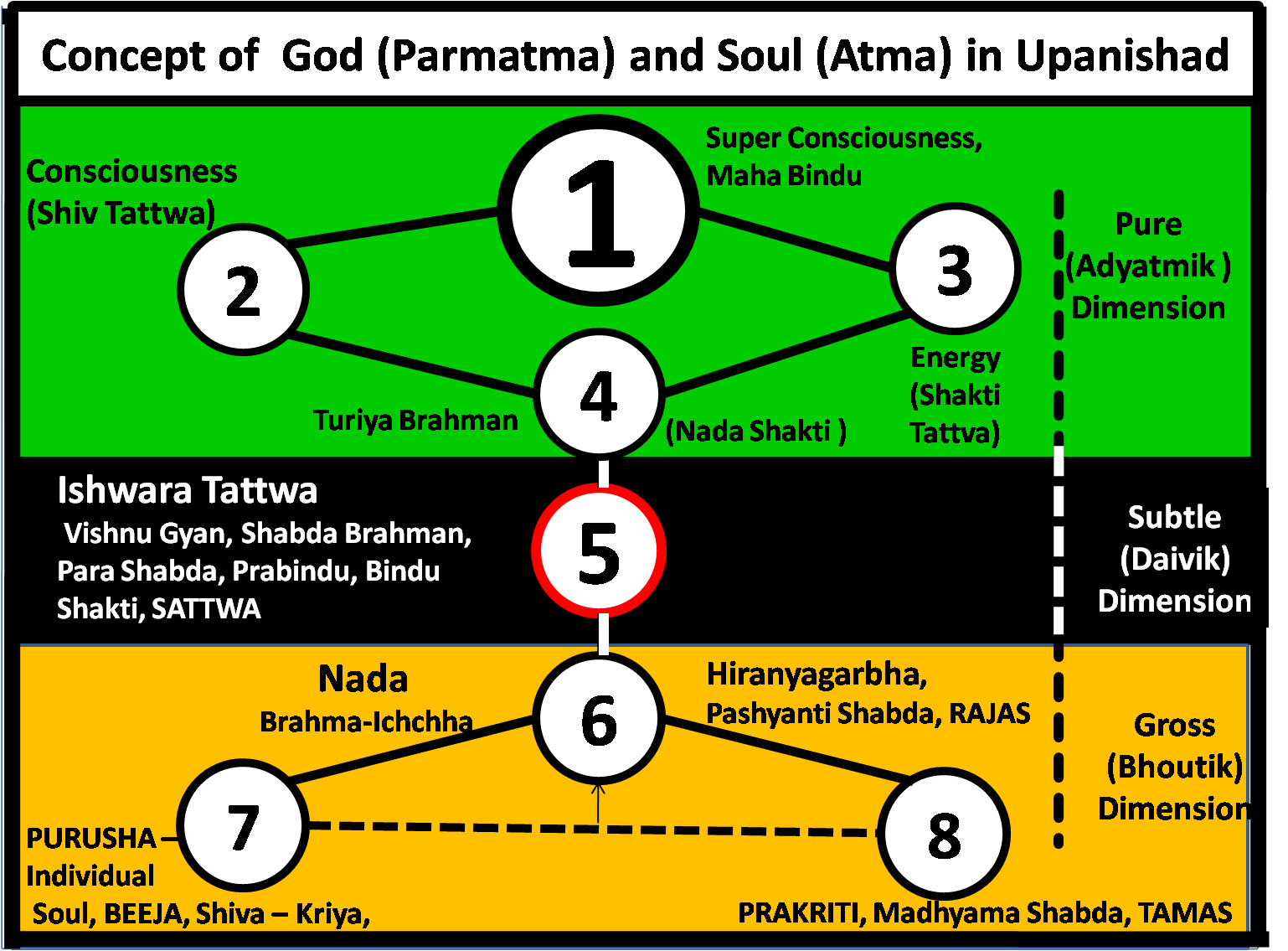
In Gross (Bhoutik) dimension or Jagat, the birth of any species including human being are taken place which have been represented by circle number 6, 7, and 8. If we look the complete scenario of the creation (from Parmatma to Jivatma), we find the position of soul and functional aspects of Antahkarna along with prana (energy). The circle number 4 resembles with the characteristics of soul. This means the soul and param soul (Parmatma or god) exists in the Pure (Adhyatmik) dimension or Loka. That is why; Swami Vivekananda has given the clarity of soul and god. He visualized that both are similar in all the respect except for their individual center and infinite center. The concept of ego emerges in gross (Bhoutik) dimension or Loka when Antahkarna (shiva) and energy (Shakti) plays a role along with nuclei.
2.2 Presence of three elements (tattva) in human creation
Let us recall the image of “Concept of God (Parmatma) and Soul (Atma) in Upanishad” where the function of the Absolute (Parmatma) and Soul (Atma) have been analyzed. The image indicates that the soul along with energy (Shakti) and space (Shiva) joins the nuclei (atman) in Subtle Loka or Daivik Jagat before creation. The existence emerges in Bhoutik Loka or physical world. The above concept clearly shows that human creation or manifestation happens because of these three elements and the same is capsulated in an image. The image “Three basic elements for human creation” describes the path and function of these elements in brief.
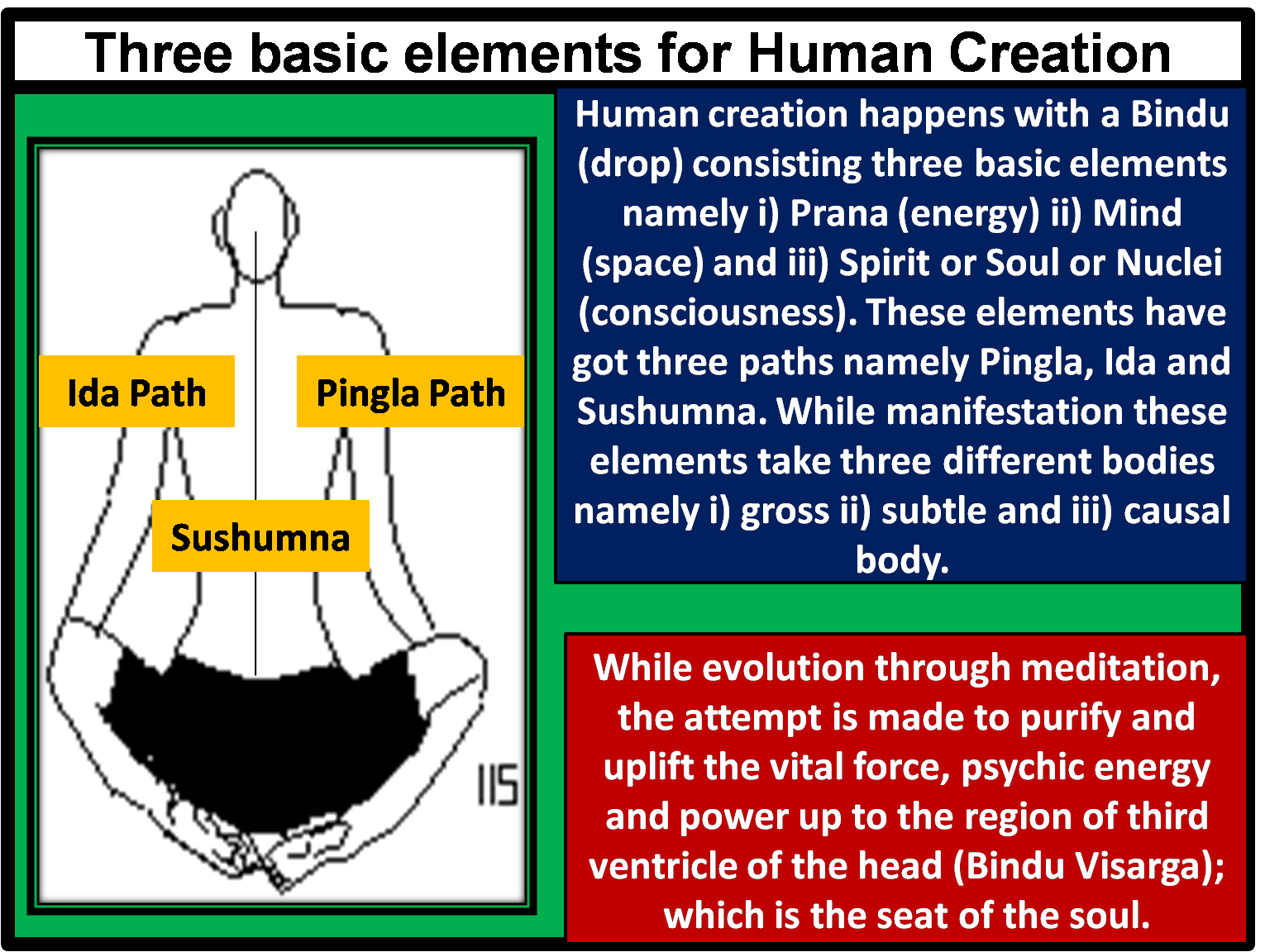
Human creation happens with a Bindu (drop) consisting three basic elements namely i) Prana (energy) ii) Mind (space) and iii) Spirit or Soul or Nuclei (consciousness). These elements have got three paths namely Pingla, Ida and Sushumna. While manifestation these elements take three different bodies namely i) gross ii) subtle and iii) causal body.
While evolution through meditation, the attempt is made to purify and uplift the vital force, psychic energy and power up to the region of third ventricle of the head (Bindu Visarga); which is the seat of the soul.
2.3 Whether they (three elements) are interdependent?
The three elements are namely i) Prana (energy) ii) Mind (space) and iii) Atma (soul) and they are functioning in Pingla, Ida and Sushumna path respectively. They (three elements) are surely interdependent. One school states that third element (Atma Shakti or Soul) which is infinite and unchangeable, does not depend on the other two (Prana and Mind) working at Pingla and Ida path. This school believes in duality. But non dual school states that these elements are interdependent and the third element working in Sushumna (Atman or soul) hooks up the other two during evolution process. Because of this nature of quarrel, the lord Buddha has eliminated the word soul from his Buddhist concept. In practice, they (three elements) are closely interlinked while manifestation as well as also while evolution.
The connectivity of breath, mind and psychic body is summarized in the image. The connecting point is protected by olfactory bulb. To transmit the functional aspects of sense organs, the neurons are getting connected in the limbic system of the brain.
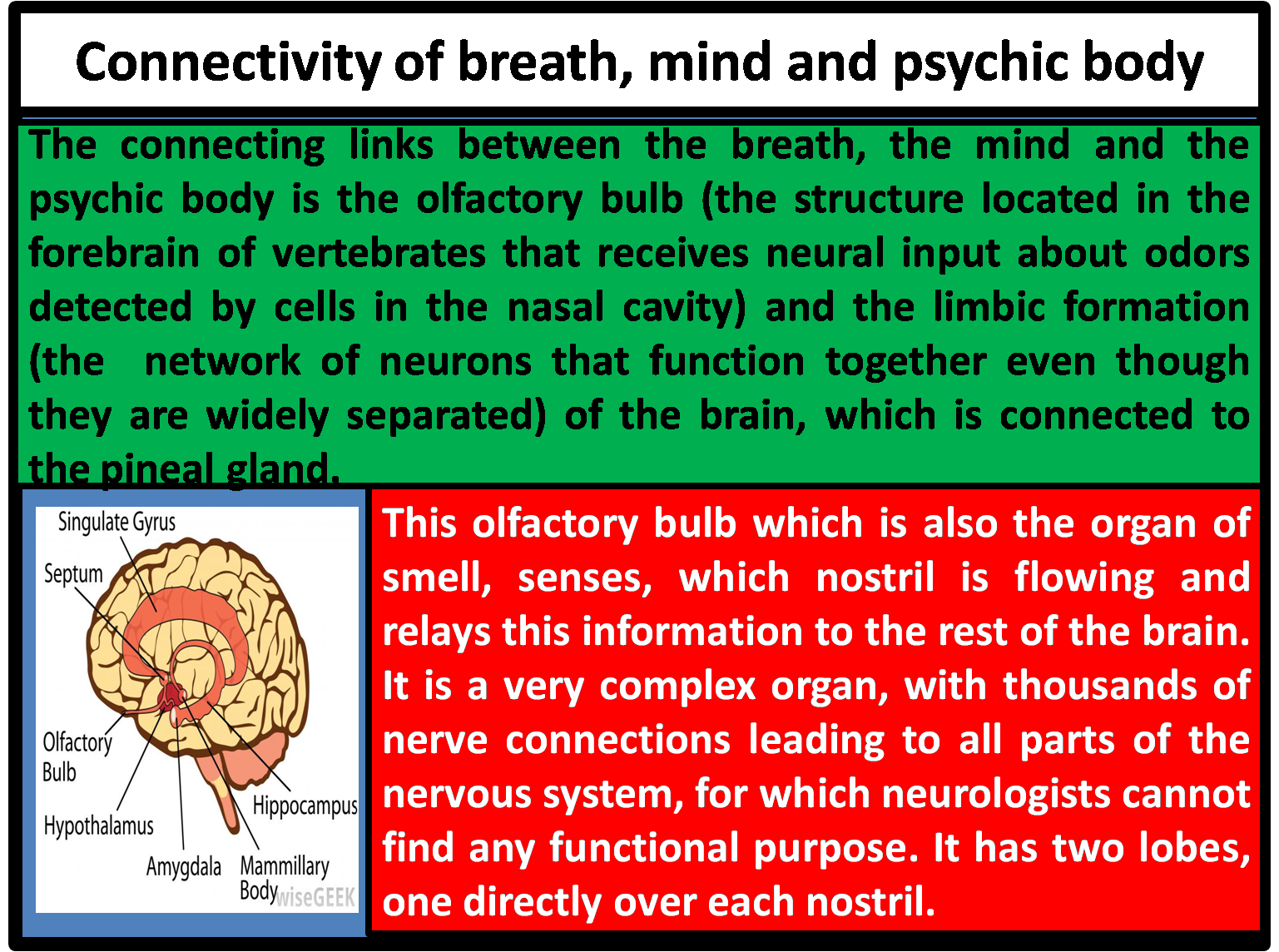
The connecting links between the breath, the mind and the psychic body is the olfactory bulb (the structure located in the forebrain of vertebrates that receives neural input about odors detected by cells in the nasal cavity) and the limbic formation (the network of neurons that function together even though they are widely separated) of the brain, which is connected to the pineal gland. This shows the importance of limbic system which virtually makes the functional connection between brain cells and neurons.
This olfactory bulb which is also the organ of smell, senses, which nostril is flowing and relays this information to the rest of the brain. It is a very complex organ, with thousands of nerve connections leading to all parts of the nervous system, for which neurologists cannot find any functional purpose. It has two lobes, one directly over each nostril. Spiritual masters have utilized this connectivity for evolving from lower mind to the middle mind or even to the higher mind. This junction is seems to be the transmitter of sensual information to the pineal gland when Agna chakra is developed. This is also the junction of nervous system.
3. Whether soul comes in human body?
The definition of soul given by Swami Vivekananda clarifies that the soul does not come in or enter or exit from the body as the same (soul) is infinite and pervading everywhere. Then question arises how the human creation is having three fundamental elements during manifestation or during evolution. Upanishad states that we as human beings have come with three fundamental elements namely prana (body), mind and soul (spirit). Two out of three elements are very important to evolve the soul and they are prana (functioning in Pingala path) and mind (functioning at Ida path). The soul exists in Sushumna and bound by three Gunas and three levels of mind along with five koshas.
3.1 How soul is made free from nature (Prakriti) and mind?
Swami Vivekananda has given the clear picture of soul which exists in nature. This means even after realisation of the soul, the same (soul) has to be made free from grip of nature (Prakriti), which is also known as Maya. This indicates that the people who are soul conscious or even realized soul will not be in a position to evolve beyond nature (Prakriti) which is the domain of Parmatma or the Absolute. Then what is the method to make the soul free from nature? The meditational approach provides the answer. Till we are in “Deep Sleep Meditation”, the soul will be in the grip of nature. This means after deep meditation (few hours after meditation), the meditator will be in the grip of Maya; of course, under less intensity. To elevate higher than nature’s boundary, there is a process of “psychic death meditation”; then the soul will be free from the grip of the Maya or nature (Prakriti). Two terms “Deep Sleep Meditation” and “Psychic Death Meditation” have been described in Bhagwad Gita (chapter 7 and chapter 8), Simplified Kundalini Yog (SKY), Yogada (YSS), and also in Meditation of Nath Panth. The yogic process adopted during these types of meditation has also been discussed in Upanishads; which are the theme of Veda.
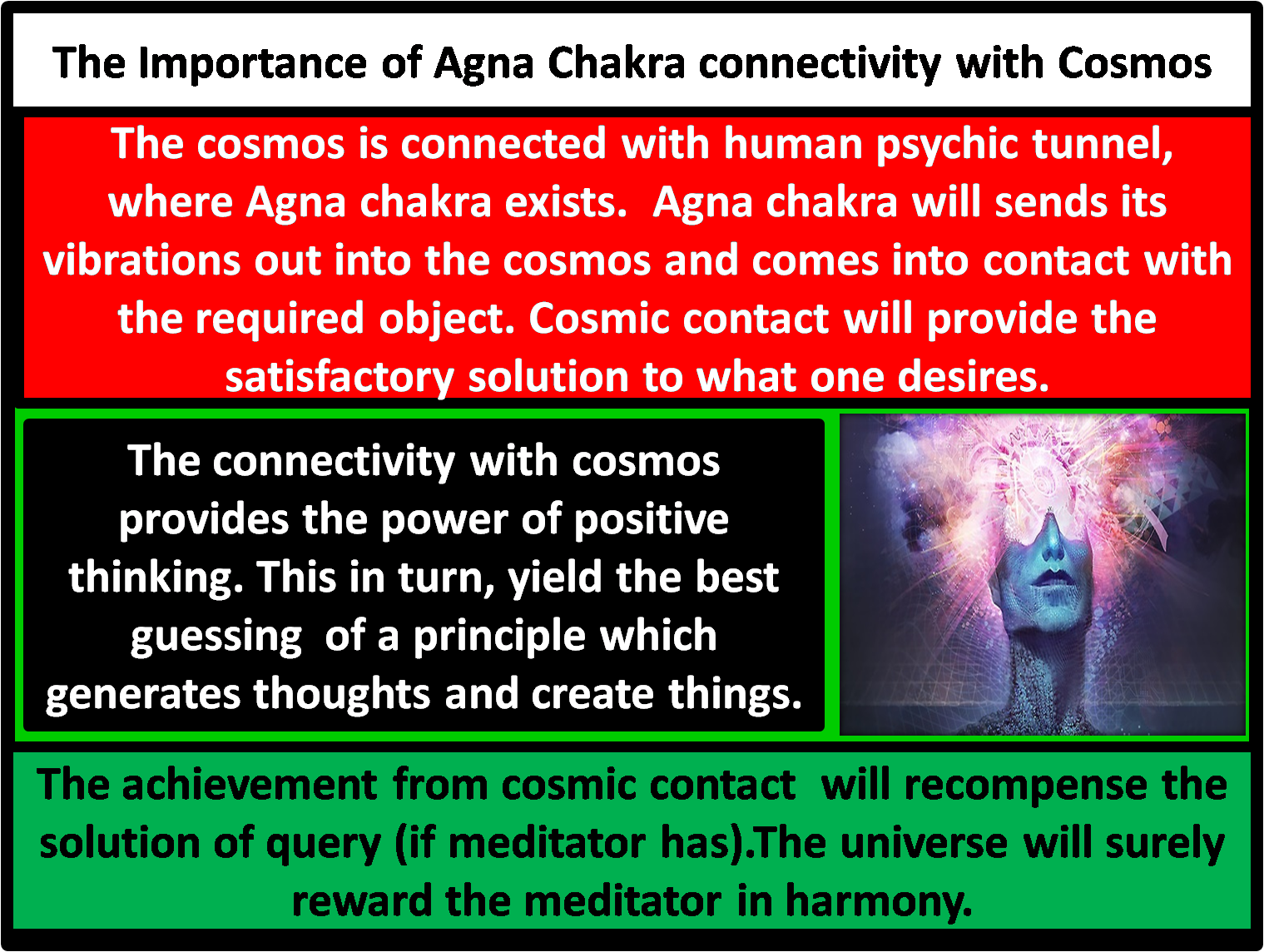
During meditation, the well developed Agna chakra (through meditation) will be connected to the cosmos and certain achievements from unknown domain of cosmos will be revealed. The image describes “The importance of Agna chakra connectivity with Cosmos” in nutshell and the same can be taken as yard stick of higher meditation.
